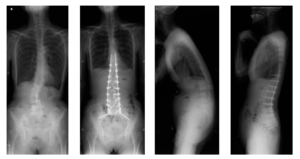Spinal Deformity (Adolescent Idiopathic Scoliosis, Adult Spinal Deformity)
2022年5月1日
最終更新日時 :
2024年11月8日
 webmaster
webmaster
I will provide information on surgical methods, length of hospital stay, and insurance coverage for spinal deformity (adolescent scoliosis and adult spinal deformity).
Spinal Deformity (Adolescent Idiopathic Scoliosis, Adult Spinal Deformity)
Symptoms
It gradually progresses and can lead to significant spinal curvature, causing cosmetic concerns, imbalance when standing, and severe lower back pain. This condition is broadly categorized into adolescent idiopathic scoliosis, which typically progresses during adolescence, and degenerative lumbar scoliosis, which is more common in older adults. In cases of adolescent idiopathic scoliosis where the curvature exceeds 30 degrees and in cases of degenerative lumbar scoliosis with severe functional limitations such as lower back curvature, pain, or difficulty in activities of daily living (ADL), corrective surgery may be considered.
Especially in older adults, such surgeries have historically been avoided due to their high invasiveness and associated risks. However, the introduction of minimally invasive surgical techniques, as shown in Figure 14, has made it possible to reduce invasiveness and risks, expanding the range of applicable patients.
If you are experiencing a curved spine and persistent pain, please do not hesitate to seek consultation. Severe spinal curvature (lordosis) can lead to constant pressure on the upper abdomen, increasing the risk of complications such as gastroesophageal reflux disease.
Especially in older adults, such surgeries have historically been avoided due to their high invasiveness and associated risks. However, the introduction of minimally invasive surgical techniques, as shown in Figure 14, has made it possible to reduce invasiveness and risks, expanding the range of applicable patients.
If you are experiencing a curved spine and persistent pain, please do not hesitate to seek consultation. Severe spinal curvature (lordosis) can lead to constant pressure on the upper abdomen, increasing the risk of complications such as gastroesophageal reflux disease.
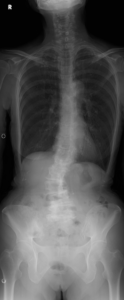
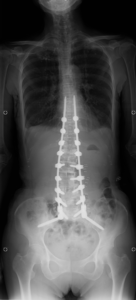
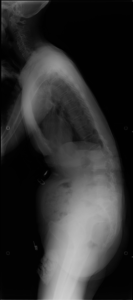
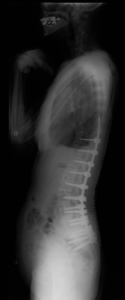
Treatment methods
The diagnosis and balance impairment due to lumbar scoliosis are assessed using spinal standing full-length X-rays.
In practice, the curvature and balance of the thoracic and lumbar spine are evaluated using quantified values such as Cobb angle, PI-LL (Pelvic Incidence - Lumbar Lordosis), and SVA (Sagittal Vertical Axis).
In practice, the curvature and balance of the thoracic and lumbar spine are evaluated using quantified values such as Cobb angle, PI-LL (Pelvic Incidence - Lumbar Lordosis), and SVA (Sagittal Vertical Axis).
Surgical methods
We perform surgery to correct the deformity and stabilize it with instrumentation. The surgery is planned to bring the preoperative quantified values closer to the ideal values described above.
Two-stage surgery with anterior and posterior approaches:
The surgery begins with an XLIF or OLIF procedure, followed by a second-stage posterior scoliosis surgery. The posterior screws are inserted using a percutaneous pedicle screw (PPS) technique rather than an open approach.
Posterior scoliosis surgery: Correction and fixation surgery are performed posteriorly using an open approach.
Osteotomy (PSO):
This procedure is performed sparingly due to its high invasiveness."
Please note that medical terminology and procedures may vary, so it's important to consult with a healthcare professional for specific information and recommendations related to your condition.
Two-stage surgery with anterior and posterior approaches:
The surgery begins with an XLIF or OLIF procedure, followed by a second-stage posterior scoliosis surgery. The posterior screws are inserted using a percutaneous pedicle screw (PPS) technique rather than an open approach.
Posterior scoliosis surgery: Correction and fixation surgery are performed posteriorly using an open approach.
Osteotomy (PSO):
This procedure is performed sparingly due to its high invasiveness."
Please note that medical terminology and procedures may vary, so it's important to consult with a healthcare professional for specific information and recommendations related to your condition.
